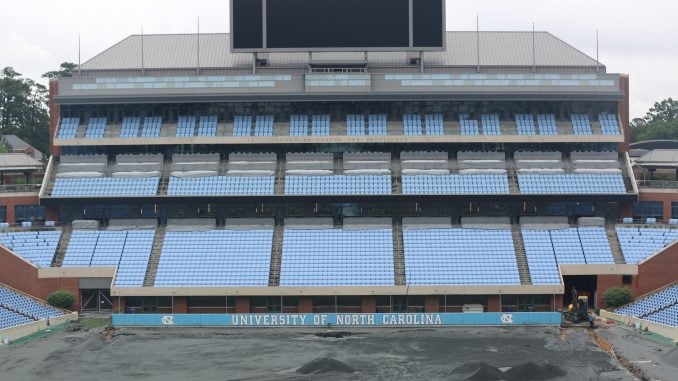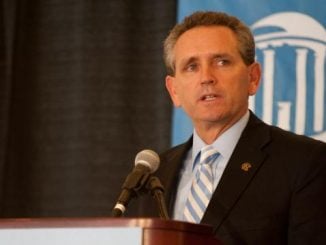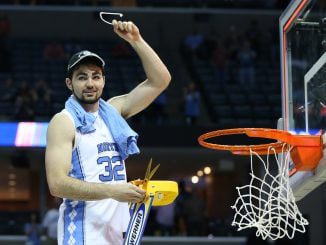
CHAPEL HILL — Everything old is new again.
Take artificial turf, for example.
Unveiled in the 1960s with the opening of Houston’s Astrodome, fake grass became a fixture at
stadiums all across the country over the next decade. But it eventually fell out of favor, especially
among athletes, due to injury risk.
But thanks to advances in technology and the growing cost of maintaining natural surfaces, artificial turf is enjoying a comeback. Among those making the switch is North Carolina, whose Kenan Stadium field is currently undergoing an extensive synthetic facelift.
“Installing AstroTurf at Kenan Stadium not only is the best option for our football team and football game day, it also benefits our other varsity programs that may want to use Kenan as a conditioning space,” UNC athletic director Bubba Cunningham said. “With 28 teams and more than 800 student-athletes, we are always looking for ways to create multi-use spaces and installing synthetic turf does that.”
The playing surface at Kenan has been a topic of conversation for the past two years because of overuse during construction of the Tar Heels’ new practice facility. Athletic officials originally resisted the changeover to artificial turf, necessitating that the field be resodded before every home game.
The subject was revisited after Mack Brown was hired as UNC’s new football coach in December. Brown prefers the consistency of a synthetic field, especially in bad weather, and supported a similar change when he was at Texas.
If there was any doubt as to the direction the Tar Heels might go, it was erased after heavy rains turned Kenan’s field into a soupy mess, raising player safety concerns during the NCHSAA state championship games that were played there.
“Those state championship games were a bit of a tipping point,” said Rick Steinbacher, UNC’s senior associate AD for marketing and corporate sponsorships. “When we saw how bad it was for those games, I wouldn’t say it put us over the edge, but it was right about the time we were trying to make the decision.”
Work on the project began after UNC’s graduation ceremony last month and is scheduled to take about eight weeks. The new surface should be ready well in advance of the Tar Heels home opener, Sept. 7 against Miami.
It’s a process Mike Bunting of contractor Carolina Green said entails much more than simply digging up the grass and rolling out a carpet to replace it.
First the 10 inches of sand that served as the old field’s base must be dug out and replaced by a bed of stones that allow for better drainage. In addition to the existing infrastructure for sound systems, video and communications, additional wiring is in the process of being installed to support new and developing technology.
“While we’re building this new field, the university asked us to put in conduit pathways for the future so we can accommodate pylon cams,” said Bunting, whose company also installed artificial surfaces on UNC’s indoor and outdoor practice fields. “And we’ve run some power to each goal post so we can have a remotely controlled camera on the uprights.”
Once that is done, a layer of shock-absorbing padding will be added before the turf finally goes down. The finishing touch will be approximately 115,000 pounds of infill, tiny rubberized pellets that make the field softer and help it look and feel more like actual grass.
The new surface was designed by a company called FitFields and is manufactured by AstroTurf. Although that brand name brings back memories of the earliest generations of fake grass, the state-of-the-art Root Zone 3D3 Blend being used at Kenan bears little resemblance to those old-school fields that were little more than a layer of synthetic turf installed over a slab of concrete.
“I hated playing on AstroTurf because it was so hard,” said Steinbacher, an all-ACC linebacker who played for Brown’s UNC teams from 1990-93. “We played a game at Army and it was like playing on asphalt.
“But then we played at the Georgia Dome and it must have been a newer kind. I’ll never forget walking out there and thinking, ‘Wow, this isn’t that bad.’ It was actually soft. Since then it’s just gotten so much closer to natural grass. They always look so good and you can get so much more use out of them.”
Steinbacher said that the new field, which is part of a renovation project that also includes upgrades to the Tar Heels’ locker room and weight facilities, will cost about $2 million to install.
Some of that price tag will be offset by the fact that the artificial surface won’t have to be constantly mowed, watered, fertilized or resodded every time it gets chewed up. Another benefit is that it can be used year-round by programs other than football, in any kind of weather.
Bunting said that while most synthetic fields come with a manufacturer’s warranty of eight years, many remain playable long beyond that time span.
“People are weighing the life cycle costs of these fields, grass versus synthetic, and they’re starting to choose fields based on what their needs are,” Bunting said. “I don’t think we call it a trend in our business anymore. (Synthetic fields) are so prevalent up and down the spectrum of professional leagues all the way down to parks and rec. You find these fields now at every level.”



